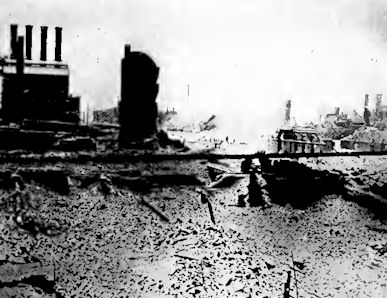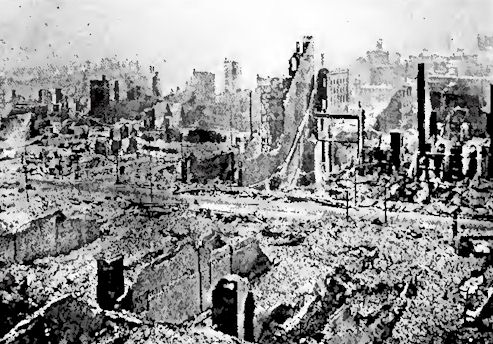The Baltimore Fire of 1904
But a
greater calamity than any of these, in the amount of
property destroyed, was the great conflagration which
swept over the city of Baltimore in the year 1904. The
fire started in the wholesale dry goods house of John E.
Hurst & Co., German Street and Hopkins Place, on the
morning of Sunday, February 7, and raged for thirty
hours, destroying almost entirely the business section
of the city and causing a loss of not far from a hundred
million dollars, a loss unparalleled except by the great
Chicago fire of 1871.

Before the alarm could reach the engine houses the whole
Hurst building was in flames, and ten minutes later an
explosion caused it to collapse and spread the fire to
the adjacent buildings in all directions. A fierce wind
blowing at the time spread the flames so rapidly that
they got beyond the control of the fire department.
After a stubborn fight the brave firemen had to confess
that they were exhausted by the strain, and aid from
other cities was asked and was cheerfully given. Engines
and men came from Washington, Philadelphia, Wilmington,
New York and other cities. Even then, with seventy
engines, the flames could not be checked, but burnt
their way fiercely to the water front and to Jones
Falls.
When
it was found that the engines were powerless, dynamite
was used, and many buildings were blown up in the hope
that the flames could not leap across the vacant spaces
left. Too often this hope proved illusory, and before
the fire was checked twenty-two banks, eleven trust
companies, the chamber of commerce, the stock exchange,
and all but one of the newspaper offices had been wholly
or partially destroyed. Railroad offices and business
buildings of every kind, wholesale and retail, and
including many of the handsomest and newest, were
burned. Nor were historic buildings spared; among others
the Maryland Institute and the Church of the Messiah
perished.

View of the Ruins at the
Corner of Baltimore and Charles Street
After the Fire.
Fortunately the fire started on a Sunday, otherwise the
loss of life in the crowded business portion of the city
would doubtless have been appalling. As it was, there
were almost no lives lost.
The Fourth and Fifth Maryland
regiments and the Naval brigade patrolled the streets
and mounted guard in the ruined district in order to
protect the buried vaults, safes, and valuables from
thieves, many of whom, it is said, flocked to Baltimore
from other cities, only to be arrested by the vigilant
police and sent away again. During the night of February
7 a company of regulars were sent into the city from
Fort McHenry to aid the police department in protecting
life and property. They were withdrawn the next day.
Later on the government at
Washington sent a company of regulars to the city to
assist the police department by guarding the government
property in the city.
At no time during the fire,
nor afterwards, in the exciting days which followed, was
the city under the control of any other body than the
legally constituted police department. Governor Warfield
issued a proclamation declaring a legal holiday from
Februarys to February 15. This was necessary, as the
banks and trust companies could not reach their vaults,
buried in the debris, for days, because of the intense
heat. Many a merchant opened his buried safe at the end
of a week, only to find the valuable contents within
burned to ashes.
Maryland
AHGP

Source: History of Maryland, by L. Magruder Passano, Wm.
J.C. Dulany Company, 1901.

|



